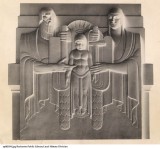Aerial photography can be traced back to 1858 when a French photographer named Gaspard-Felix Tournachon captured an image of Paris while riding in a hot-air balloon. The field developed further in the late 19th century with the use of kites.
But aerial photography as we know it today, really progressed during World War I, thanks in part to the Eastman Kodak Company.
Both the Allied and Central Powers were engaging in aerial image capturing before the United States entered the war in 1917, but the Rochester-based firm nevertheless contributed to both the development of, and instruction in, the new techonology.
Kodak not only created the Kodak A-2 aerial camera which was widely used during the war, but it also instigated the establishment of the U.S. Aerial Photography School in Rochester.
In early 1918, the company offered the federal government two acres of floor space of its new building at Kodak Park to serve as the school’s barracks, dark rooms, class rooms and lecture halls.
The local YMCA and Knights of Columbus organizations jointly proposed to construct a recreation hall by the campus outfitted with a library, a billiards room and a “Liberty Theatre,” to meet the entertainment needs of the young recruits.
Mayor Edgerton in turn offered up the section of Genesee Valley Park known as Baker Field to house an airplane hangar.
The hangar would not host a flying school, nor would the airplanes’ camera operators be the ones attending the Kodak Park institution.
Aerial camera operators did not actually have a hand in developing and printing photographs. This work, done by “ground men,” was to be the focus of the Kodak Park school.

Announcing the establishment of the new institution in early 1918, the U.S. Signal Corps sent a bulletin to local draft boards indicating, “The camera is playing a very important part in the war of 1917, and the Signal Corps is organizing the largest and most up-to-date photographic division in the world. The corps is calling on amateurs and professionals to aid the reconnaissance and to help write the story of the war in pictures.”
The school’s Commandant, Captain Charles Betz, proclaimed: “This is an admirable opportunity for men with photographic experience to turn in and do their part. Rochester, the Kodak City, should do its share, and I am certain it will give us two hundred students.”
A considerable number of Rochesterians were among the thousands of amateur and professional photographers who applied to the school.
The first recruits arrived to the Kodak Park campus in March, 1918 and were given instruction in military drill and trained in the school of the soldier well before they were schooled in aerial photography.

Inspection at Kodak Park
Students then underwent a highly intensive 4-week course specializing in photo developing and printing as well as camera repair. Recruits learned how to develop film under time constraints and in varying climates and conditions in order to prepare them for the challenges of working with film in special vehicles close to enemy lines.

Aerial Photo of Highland Park by Private Prongay
Armistice was announced just eight months after the Kodak school opened. When demobilization of the Aerial School began in December 1918, it was the last military unit left in the city.
Though the institution was short-lived, its impact on the war effort was nevertheless significant. By the time it officially closed on January 1st, 1919, the Kodak school was responsible for having trained more than 2,500 people in the art of aerial photography.
-Emily Morry

[…] The Kodak City goes to War: Rochester’s Aerial Photography School […]
[…] snap photos through a hole in the cockpit floor. At its headquarters in Rochester, Kodak ran the U.S. Aerial Photography School, an intensive training program for American soldiers tasked with developing surveillance photos […]
[…] snap photos through a hole in the cockpit floor. At its headquarters in Rochester, Kodak ran the U.S. Aerial Photography School, an intensive training program for American soldiers tasked with developing surveillance photos […]
[…] snap photos through a hole in the cockpit floor. At its headquarters in Rochester, Kodak ran the U.S. Aerial Photography School, an intensive training program for American soldiers tasked with developing surveillance photos […]